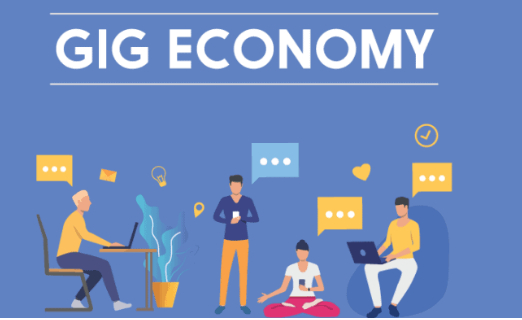
Disclaimer: Copyright infringement not intended.
Context
- Recently, NITI Aayog launched a report titled ‘India's Booming Gig and Platform Economy’.
About the Report
- The report is a first-of-its-kind study that presents comprehensive perspectives and recommendations on the gig–platform economy in India.
- The report provides a scientific methodological approach to estimate the current size and job-generation potential of the sector.
- It highlights the opportunities and challenges of this emerging sector and presents global best practices on initiatives for social security.
- It delineates strategies for skill development and job creation for different categories of workers in the sector.
What is Gig Economy?
- A gig economy is a free market system in which temporary positions are common and organizations hire independent workers or freelancers for short-term commitments instead of full-time long-term employees.
- Examples of gig workers include freelancers, independent contractors, project-based workers and temporary or part-time hires. Gig apps and digital technology are often used to connect customers and gig workers.
- So, instead of a regular wage, workers get paid for “gigs”.
Drivers of the Gig Economy:
Emergence of the digital age
- Here, workforce is highly mobile and work can be done from anywhere, anytime. This means that you need not reach at the location of the organization to do the job.
Firms:
- In the era of disruption it will be safe as it avoids long term obligations like pension and other emoluments, when they provide short term contract. The worker can be relieved at any time without any friction.
Other:
- The short-term engagements better fit for the workers to search for the best.
- Software and technological changes taking away human efforts also contributed to the gig economy.
- Temporary nature of projects and greater specializations, added to this trend.
- Uncertain business climate and declining profits in the context of disruptive innovations also tempted companies to go for short-term labors.
Pros and Cons of the gig economy
Here, we summarize some of the advantages and disadvantages of developing the gig economy for both workers and businesses.
Advantages of the gig economy
In general, the benefits of the gig economy for workers are:
- More flexible and more mobile: Workers have more alternatives to optimize time and income. They can also complete tasks on the go and can better balance work with family.
- Freedom to choose jobs: Workers can choose the type of project they will take on. Also, project options are more varied because they come from companies around the world.
- More opportunities to earn a higher income: Workers can take on several jobs at once. They may focus on one big project and take on several small jobs to add their income.
For businesses, the gig economy is beneficial because:
- Facilitates operating efficiency: Hiring part-time workers is a cheaper and more efficient alternative. The company does not need to pay for training fees or benefits such as insurance. That helps lower operating costs.
- More choices: They can select some of the best individuals in their field, according to the company budget. Options are more varied because the supply comes from local workers and from all over the world.
- Lower fixed costs: Businesses do not need to provide office space, equipment, and facilities. That reduces fixed costs, enabling them to quickly break-even and economies of scale.
In a nutshell GIG Economy,
- Cater to immediate demand:Gig economy can benefit workers, businesses, and consumers by making work more adaptable to the needs of the moment and demand for flexible lifestyles.
- Cheaper and more efficient: Most times, employers cannot afford to hire full-time employees.In a gig economy, large numbers of people work part-time or in temporary positions. The result is cheaper, more efficient services, such as Uber or Airbnb, for those willing to use them.
- Wider choice to employers: Technology and connectivity through the internet don’t require the freelancer to come into the office for work.Hence, employers have a wider range of applicants to choose from as they don't have to hire someone based on their proximity.
- Offers specific expertise: Professional services firms are hiring gig workers to add deep domain expertise to client-impact teams. Majority of professional services contact workers have years of domain-specific knowledge, like consultants.
- The wider choice to employees: People often find they need to move around or take multiple positions to afford the lifestyle they wanThese days, people also tend to change careers many times throughout their lives; the gig economy is a reflection of this rising trend.
- Youth economic productivity: India has a high share of young population which is only expected to grow. According to economists at IMF, youthinactivity in India is at 30%, the highest amongst developing countries. The gig economy offers the perfect platform for engagement of youth in productive employment activities.
- Gender parity: It is also estimated that the gig economy offers a relatively high gender-parity in the workforce, as compared to traditional employment. Most of the workers working in the food delivery business in South East Asia are women workers.
Disadvantages of the gig economy
Not forever, part-time work benefits everyone. There are several downsides to doing such work:
- Do not get allowances: Workers don’t receive benefits, such as insurance and pensions. Businesses pay them according to the contract. Therefore, they must be selective in choosing jobs.
- Pay taxes from their own pocket: If they become permanent workers, the company may pay their income tax. On the other hand, if they work part-time, they don’t get that kind of benefit.
- Less stable income: Workers must pursue projects to secure income. But it is a difficult task. They have to compete with individuals around the world. Thus, the market demand for a particular job is lower than the available labor supply. As a result, getting multiple projects at once is more complicated.
For businesses, outsourcing work to the part-time workforce also raises several problems, such as:
- Workers are less reliable: The chances of hiring inappropriate workers are higher. Without a rigorous selection process for hiring permanent employees, companies don’t know if they are reliable or just a mere appearance.
- No experience effect for businesses: Firms cannot reach a cost reduction from specialization and experience effects. It contrasts with permanent workers whose experience effect allows them to become more skilled and more productive.
In a nutshell, associated challenges include:
- There is no certainty, stability or job security in gig economy.
- Workers can be terminated anytime here in a gig economy.
- Workers do not have a bargaining power in a gig economy.
- Workers do not get pensions, gratuity, perks etc that is available for full-time workers.
- There is no basis on which banks and other financial service providers can extend lines of credit when steady income is not assured.
- The social welfare objectives can be neglected if business and profitable avenues of freelancing are prioritized.
- It is not accessible for people in many rural areas where internet connectivity and electricity still is a distant dream. Hence they are deprived of this opportunity and this stems up inequality debate again.
- Confidentiality of documents etc of the workplace is not guaranteed When there is a situation where gig worker is potentially working for others as well, including competitors, the employer is wary of what he shares with the gig worker and perennially suspicious.
- Work culture: Temporary workers who come and go in an organization make it difficult to maintain consistent relationships among workers, employers and clients on a long-term basis.
- Work-life management challenges: Gig work can be disruptive if the worker isn't used to making their own schedule. Inexperienced workers can easily take on too many gigs, leading to overwork and burnout.
- In few work projects where teamwork is essential, gig economy becomes dysfunctional in such a scenario.
- It is still in a nascent stage in a country like India.
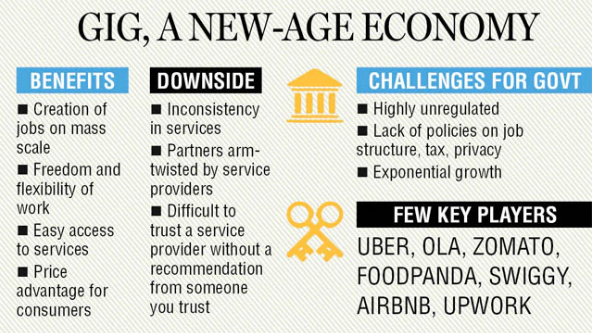
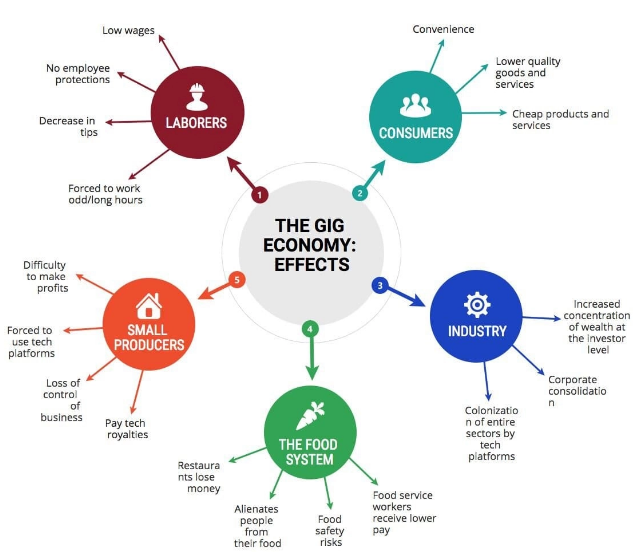
India’s Gig Economy
- There are now close to 15 million gig workers in India. Delivery boys, cleaners, consultants, bloggers, etc., are all part of the gig economy.
- The number of flexi or gig jobs could soar to 90 million in 8-10 years, with total transactions valued at more than $250 billion, contributing an incremental 1.25% to India’s gross domestic product (GDP) - Report by consulting firm Boston Consulting Group (BCG) and Michael & Susan Dell Foundation.
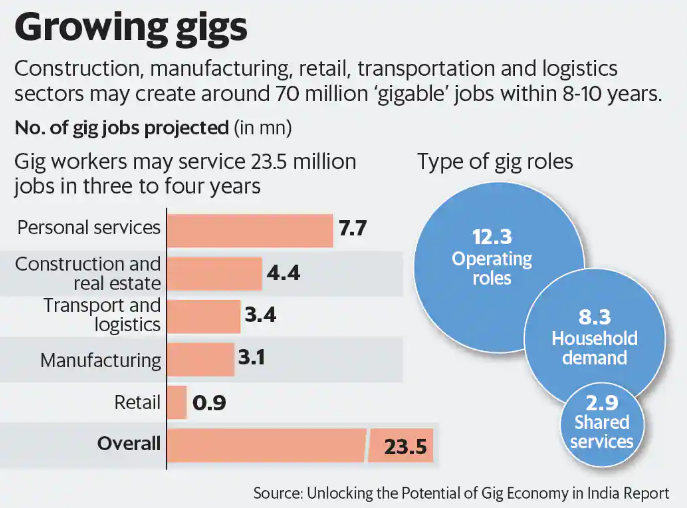
- The gig economy has the potential to service up to 90 million jobs in India’s non-farm economy alone, transact more than $250 billion in volume of work, and contribute an incremental 1.25% approximately to India’s GDP over the long term.
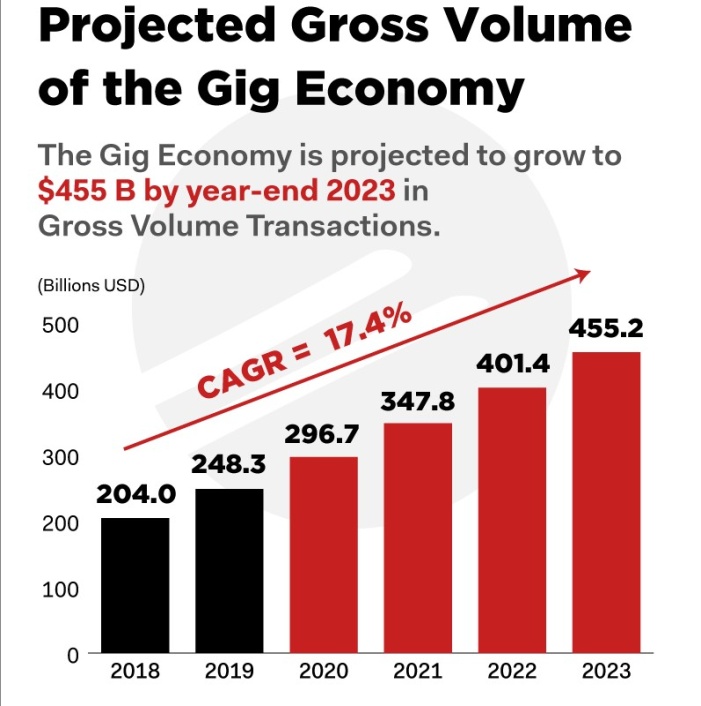
Recommendations made by the recent Report titled as ‘India's Booming Gig and Platform Economy’
- To harness the potential of the gig-platform sector, the report recommends:
- Accelerating access to finance through products specifically designed for platform workers,
- Linking self-employed individuals engaged in the business of selling regional and rural cuisine, street food, etc., with platforms to enable them to sell their produce to wider markets in towns and cities.
- Platform-led transformational and outcome-based skilling,
- Enhancing social inclusion through gender sensitization and accessibility awareness programmmes for workers and their families
- Extending social security measures in partnership mode as envisaged in the Code on Social Security 2020.
- Undertaking a separate enumeration exercise to estimate the size of the gig and platform workforce
- Collecting information during official enumerations (Periodic Labour Force Survey) to identify gig workers.
Way Forward
Giving due effect to the Code on Social Security
- For the 1st time, the Code on Social Security, 2020 acknowledges platform workers and gig workers as new occupational categories. With that, the platform workers are eligible for benefits like life and disability cover, old age protection, maternity benefits, provident fund, employment injury benefits, etc.
- Implementation of the Code is the need of the hour.
Take examples from global best practices
- Amendments to labour laws in Ontario and California have shown a move towards granting employee status to platform workers, thus guaranteeing minimum wage and welfare benefits. This is the view propagated by international agencies in the EU, including the European Trade Union.
- So, the Government of India should also consider granting the gig workers the status of employees of the aggregators. That would automatically provide them all the labor benefits like PF and ESI.
Provide chances to gig workers to become independent entrepreneurs
- The Government should consider providing a loan scheme to the platform workers, to end their dependency on the platform aggregator companies.
Up scaling Technology platforms
- The gig economy presents an opportunity for India to drive job creation and economic growth.
- Technology platforms operating at scale within an ecosystem of information and services can help unlock efficiency, bring in demand-supply transparency, and drive greater formalization and financial inclusion.
https://www.pib.gov.in/PressReleasePage.aspx?PRID=1837277
1.png)



















